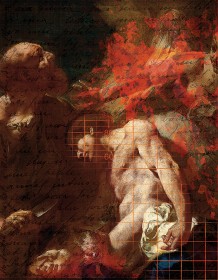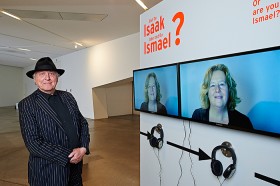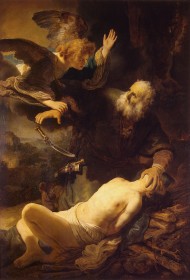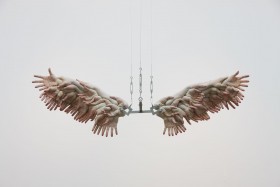The exhibition “Obedience: An Art Installation in 15 Rooms by Saskia Boddeke & Peter Greenaway” is about to open. It reflects on the biblical story of Abraham, a forefather willing to sacrifice his son in compliance at God’s command.The installation is still being set up when the catalog arrives, hot off the press. It comprises an art book designed by Peter Greenaway as well as a compilation of essays. The artist and filmmaker took a break from the hectic pre-opening preparations to talk with Mirjam Wenzel about the meaning of the biblical story, and the notion of text, image and blood.
Mirjam Wenzel: The biblical story in the Book of Genesis 22 holds an awkward place in Jewish memory and has given rise over the centuries to many theological debates and artistic interpretations. We had been considering doing an exhibition about this story and its reception for a very long time. What did you think when we approached you with the idea of creating this exhibition? How do you perceive this biblical story?
Peter Greenaway: I think that when making an exhibition it is as important to attend to form and language as to content. The content is always maneuverable, adjustable, and ever subjective. This story consists of very many meanings, and infinite variations and interpretations, put to many purposes. There is no single meaning. The meaning is elusive, perhaps even purposefully so. The content in this case is curiously about a non-event, an action that never happened. Abraham was told not to kill his son.
I would be always skeptical about religious beliefs, thinking that they are local manifestations of particular political circumstances maneuvered by a local need or desire. And if you are convinced that there is no such thing as a God, or that every God is a man-made manifestation created to serve a man-made purpose, then the whole biblical story is reduced in significance: it becomes a fable, a mythology servicing a man-made proposition; this is an anecdote about a non-event initiated by a non-existing God, a most mortal thing. But it is an anecdote that has excited many imaginations. It could and indeed should be a subject for an exhibition.
If you see the whole biblical story that way then who is the messenger of God, who prevents Abraham from killing his son and prohibits the deed?
It has been said that the angel is a very late introduction into an ancient story, a symbol that does not exist in the original. My understanding is that the angel is a voice of conscience introduced to salve and ameliorate an unacceptable story that goes against the grain of all civilization; a device to abate the humanly unacceptable desires of “the elders,” elderly men playing brinkmanship power-games to bolster their authority.
You’ve mentioned that you are generally more interested in questions of form and this is quite obvious from the colorful art book that accompanies the exhibition. In combination with your artworks, photographs of families, and stills from the “I am Isaac” installation in the exhibition, the book presents various images of the Binding of Isaac, in particular details from baroque paintings. Why did you choose to re-present and re-contextualize existing images?
I have a background in cinema and have always wished cinema to prioritize the image. We have a text-based cinema. Every film you have ever seen starts its life as a text. I am hoping to use the catalog to once again prioritize the image. We have made a catalog that contains minimal text. In the age of digital notions of education and knowledge there is still a great desire to support the image with text as though images were not powerful enough or comprehensive enough. With text, we are all very sophisticated and literate across all the language barriers, to such an extent it feels that we are all, by comparison, visually illiterate. In the beginning was the image, not the text. God asked Adam to name everything. How could Adam invent text if there was no image?

Peter Greenaway, Untitled, 2015 (using a painting by Giovanni Battista Piazzetta: The Sacrifice of Isaac (detail), ca. 1715 © Museo Thyssen-Bornemisza / Scala, Florence) © Peter Greenaway
Two motifs in the art book are visually significant: the first one is blood. Your paintings and the entire book are dipped in blood. Whose blood is it?
The images of blood in the catalog reflect the images of blood in the exhibition. When civilization goes wrong, there is blood. Think of all the dramas of blood throughout history, think of them in life, and think of them in painting and theater, think of the images of blood in all the representational arts – omnipresent, ubiquitous, universal.
The second very striking motif can be found on the last page: while all the other images depict an Abraham who pauses before committing murder, the last one shows a prisoner being decapitated.
That of course is meant to resonate with what has been happening in the world very recently. But the image of decapitation reflects on a cultural practice in general. It is the ultimate notion of separating the brain or the spirit or the imagination or the mind from the rest of the body. It’s a very powerful image that speaks across all our languages, and all our systems of cultural behavior.
I have four children and the idea of sacrificing them is totally unacceptable. I feel it is not enough to think that this story belongs alone to a Jewish or Christian or a Muslim tradition. To cut the thinking and the feeling away from the body – it’s a story of denial: don’t think, don’t feel, and don’t object – be obedient. It’s the story of the old men demanding obedience sending the young men to war.
Last but not least, now, another story: You see your art book for the exhibition as the Greenaway Catalog No. 29 of 92. What is the concept behind your series of 92 catalogs?

Peter Greenaway in front of the “I am Isaac” installation
© Jewish Museum Berlin, Photography: Yves Sucksdorff
I enjoy making catalogs. A catalog can be like a film in book form, the pages are the frames, the turning of the pages is akin to moving through the film; maybe it is a superior form to a film because you can go backwards and you can go at your own pace and not the pace of the film director. I promised myself several years ago that I would try to make a bookshelf of 92 catalogs, primarily constructed of images relative to a project that demonstrated the significance of uranium. 92 is the atomic number of uranium. In the struggle to find an energy form that will sustain world civilization for thousands of years to come, I believe we will turn to uranium as our power source. And from our present information perspective, this is going to either create or break civilization. Nirvana or Armageddon. So the 92 publications, the 92 catalogs on all manner of exhibitions, films and painting shows, and of which this catalog is number 29, are reflections on that information perspective.
The interview was conducted in the midst of exhibition mounting by Mirjam Wenzel, Media

